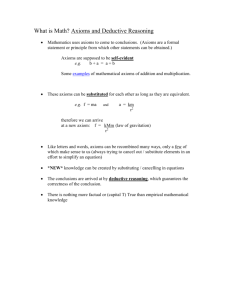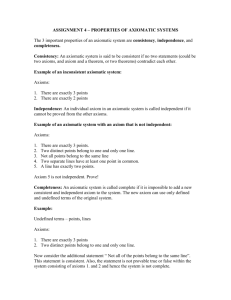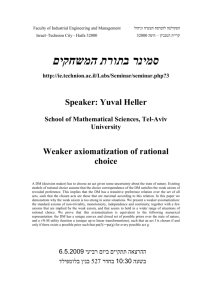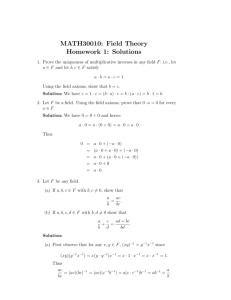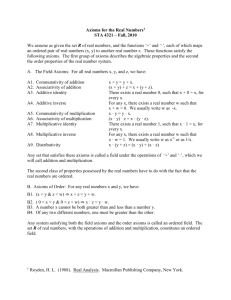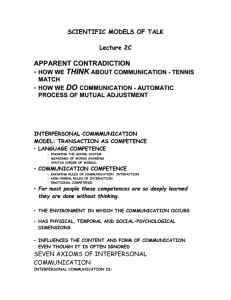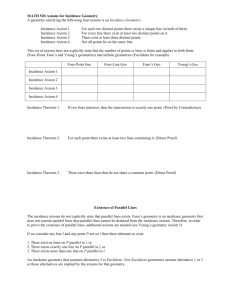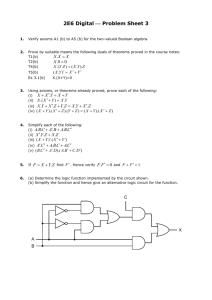A 1
advertisement
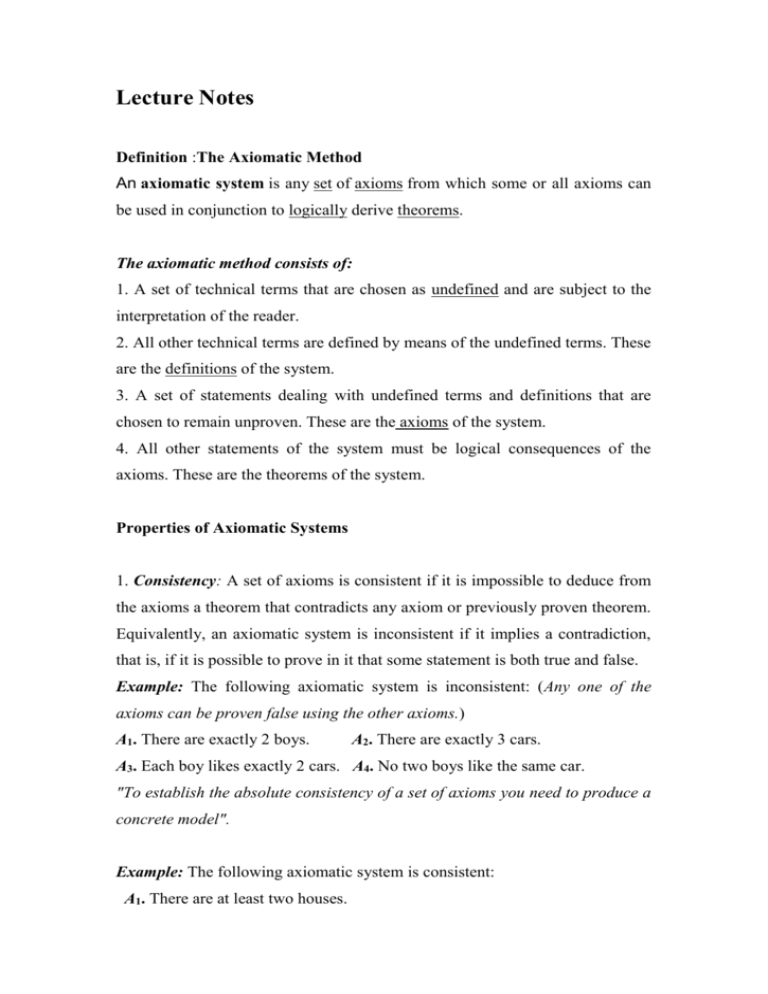
Lecture Notes
Definition :The Axiomatic Method
An axiomatic system is any set of axioms from which some or all axioms can
be used in conjunction to logically derive theorems.
The axiomatic method consists of:
1. A set of technical terms that are chosen as undefined and are subject to the
interpretation of the reader.
2. All other technical terms are defined by means of the undefined terms. These
are the definitions of the system.
3. A set of statements dealing with undefined terms and definitions that are
chosen to remain unproven. These are the axioms of the system.
4. All other statements of the system must be logical consequences of the
axioms. These are the theorems of the system.
Properties of Axiomatic Systems
1. Consistency: A set of axioms is consistent if it is impossible to deduce from
the axioms a theorem that contradicts any axiom or previously proven theorem.
Equivalently, an axiomatic system is inconsistent if it implies a contradiction,
that is, if it is possible to prove in it that some statement is both true and false.
Example: The following axiomatic system is inconsistent: (Any one of the
axioms can be proven false using the other axioms.)
A1. There are exactly 2 boys.
A2. There are exactly 3 cars.
A3. Each boy likes exactly 2 cars. A4. No two boys like the same car.
"To establish the absolute consistency of a set of axioms you need to produce a
concrete model".
Example: The following axiomatic system is consistent:
A1. There are at least two houses.
A2. For any two distinct houses, there is exactly one street connecting them.
A3. No street connects all houses.
A4. Given any street S and any house H not on S, there is exactly one
street on which H lies, but none of the houses on S lie on this street.
Producing a concrete model to establish absolute consistency is not always
possible. Alternatively, we can establish the relative consistency by producing
an abstract model.
2. Independence: An axiom is independent if it cannot be logically deduced
from the other axioms in the system. The entire set of axioms is independent if
each axiom is independent. To show that an axiom is independent you
produce a model in which that axiom is incorrect and the rest of the axioms
are correct. Remember from logic that only correct statements may be
logically deduced from correct statements.
3. Completeness: An axiomatic system is complete if it is impossible to add
an additional consistent and independent axiom without adding additional
undefined terms.
It is often quite difficult to prove that a set of axioms is complete. An easier
approach is to prove that the set of axioms is categorical which means that
each of its models is isomorphic to every other model. It is a proven result,
that if a system of axioms is categorical, then it is complete.
Note that, two models are isomorphic if there is a 1-1 correspondence between
the elements of the models which preserves all relations existing in either
model.
Exercise: Show that the following system is not categorical. (Hint: Show that
the system has two completely different models)
A1. There exist five points
A2. Each line is a subset of those five points.
A3. There exist two lines
A4. Each line contains at least two points.
Exercise: Show that the following system is categorical. (Hint: Show that the
system has exactly one model)
A1. There exist exactly three distinct points.
A2. Any two distinct points have exactly one line on them.
A3. Not all points are on the same line.
A4. Any two distinct lines have at least one point in common.
Exercise: Consider a set of undefined elements, S, and the undefined relation R
which satisfies the following axioms:
A1. If a ∈ S then aRa.
A2. If a; b ∈ S and aRb then bRa.
A3. If a; b; c ∈ S, aRb, and bRc, then aRc.
1. Find a two models for the system.
2. Are the axioms independent?
Solution:
1. a) Let S be the set of students on the HU. Let R be the relation “has the same
hair color” or “has the same weight”.
b) Let S be the set of triangles. Let R be the relation “is congruent to” or “is
similar to”.
3. To show that the axioms are independent, consider the following:
A1 is independent: Let S = {x; y; z} and R = {(x; x); (y; y); (x; y); (y; x)}.
Clearly the relation R on S satisfies axioms A2 and A3 but not A1.
A2 is independent: Let S be the set of real numbers, and let R be the relation “is
less than or equal to”.
A3 is independent: Let S be the set of students on the Cortland campus and let
R be the relation “is an acquaintance of”.
Examples of Axiomatic Systems:
Example 1(The Four-Point Geometry:)
The undefined terms are point, line and on. The axioms are:
A1. There exists exactly four points.
A2. Any two distinct points have exactly one line on both of them.
A3. Each line is on exactly two points.
Theorem : The Four-Point geometry has exactly six lines.
Proof: Home Work
Theorem : In the Four-Point geometry, each line has exactly one line parallel
to it.
Proof. By A2 each point in the geometry is connected to each of the other
points by a line. Hence each point has at least three lines on it. Assume a point
has 4 lines on it. This 4th line cannot be on any of the other three points
without contradicting A2. By A3 this line has two points on it so the geometry
has at least 5 points in it which contradicts A1. Hence each point has exactly 3
lines on it.
Now given a line l, it has two points on it, say P1 and P2. By A1 there is a point
P3 not on l. Now this point has three lines on it, and by A2 two of them
intersect l. Hence l has at least one line parallel to it. Assume there is a second
line parallel to l. This line is not on P3 since it already has three lines on it. It
also is not on P1 or P2, hence either this line has one point on it which
contradicts A2 or has two points on it which contradicts A1. Hence each line in
the geometry has exactly one line parallel to it.
Example 2(Fano's Geometry):
The undefined terms are point, line and on. The axioms are:
A1. There exists at least one line.
A2. There are exactly three points on every line.
A3. Not all points are on the same line.
A4. There is exactly one line on any two distinct points.
A5. There is at least one point on any two distinct lines.
Definition : The plane-dual of a geometry is obtained by interchanging the
words “line” and “point” in the axioms determining the geometry
Homework . 1. Define the plane dual of the Four-Point geometry. This is
called the Four-Line geometry. Make a drawing representing the Four-Line
geometry.
2. Consider the following Axioms:
A1. There exists exactly five points.
A2. Any two distinct points have exactly one line on both of them.
A3. Each line is on exactly two points.
(a) Make a drawing representing the Five-Point geometry.
(b) State and prove two theorems in the Five-Point geometry.
(c) Make a drawing representing the plane dual of the Five-Point geometry.
3. Write the plane dual of the axioms of Fano’s geometry and draw a
representation of a model satisfying these axioms.
HILBERT'S AXIOMS
Hilbert's system was not the first, but his axioms are perhaps the most intuitive and
are certainly the closest in spirit to Euclid's.
During the first quarter of the twentieth century Hilbert was considered the leading
mathematician of the world. He made outstanding, original contributions to a wide
range of mathematical fields as well as to physics. He is perhaps best known for his
research in the foundations of geometry as well as the foundations of algebraic
number theory, infinite-dimensional spaces, and mathematical logic. A great
champion of the axiomatic method, he "axiomatized" all of the above subjects except
for physics (although he did succeed in providing physicists with very valuable
mathematical techniques). He was also a mathematical prophet; in 1900 he predicted
23 of the most important mathematical problems of this century.
He has been quoted as saying: "One must be able to say at all times - instead of
points, lines and planes - tables, chairs and beer mugs." In other words, since no
properties of points, lines, and planes may be used in a proof other than the properties
given by the axioms, you may as well call these undefined entities by other names.
Hilbert's axioms are divided into five groups: incidence, betweenness, congruence,
continuity, and parallelism. We have already seen the three axioms of incidence. Now
we will deal successively with the other groups of axioms.
Incident Geometry
We assume only the undefined terms:
"point" and "line" and the undefined relation "incidence" between a point and a line,
written P lies on l or l passes through P.
The Axioms:
INCIDENCE AXIOM 1. For every point P and for every point Q not equal to P
there exists a unique line l incident with P and Q.
INCIDENCE AXIOM 2. For every line l there exist at least two distinct points
incident with l.
INCIDENCE AXIOM 3. There exist three distinct points with the property that no
line is incident with all three of them.
Notes:
1. We can now assert that every line has points laying on it - at least two, possibly
more - and that the point's do not all lie on one line.
Moreover, we know that the geometry must have at least three points in it.
2. There exist distinct points A, B, and C.
3. For every line, at least one of these points does not lie on the line.
Definitions:
1. Collinear: Three points are said to be collinear if there exist one line passing
through the three points.
2. Concurrent: Three lines are said to be concurrent if there exist one point in
common of the three lines.
3. Parallel: Two lines are said to be parallel if there is no common point between
each of them.
Propositions:
PROPOSITION 2.1. If l and m are distinct lines that are not parallel, then l and m
have a unique point in common.
Proof: Suppose that l and m are two distinct lines that are not parallel, thus there
exist at least one point lies on l and m (say the point P). Let Q be any point distinct
from P that lie on l and m. We must show that this yield a contradiction. P and Q are
two distinct points lie on l and m and using axiom 1(For every point P and for every
point Q not equal to P there exists a unique line l incident with P and Q) l and m must
equal (not distinct) which contradict the fact that l and m not parallel(are distinct),
this contradiction appear since we assume that Q is different from P, therefore P must
equal to Q.
PROPOSITION 2.2. There exist three distinct lines that are not concurrent.
Proof:
We construct three non concurrent lines:
From axiom3 there are three points not on the same line, say A, B and C. there exist
unique line say l incident on A and B (axiom1), and there exist a unique line say m
incident on B and C (axiom1), and there exist unique line n incident on C and A
(axiom1),. We show that l, m and n are distinct lines:
If l equal to m then A,B and C laying on one line (since A, B are laying on l and B and
C are laying on m) which contradict the fact that A, B and C can't lie on the same
line.
This contradiction happened from the assumption that l is equal to m.
In the same manner we can show that l, n are distinct, and n, m are distinct.
Therefore there exist three distinct lines.
We show now these three lines are not concurrent: Home work
PROPOSITION 2.3. For every line there is at least one point not lying on it.
Proof: Let l be any line, we show that there is one point not laying on l, suppose not,
that is l passing through each point in the system, this contradict the axiom3 (there
exist at least three non collinear points).
(Exercise): why we get contradiction in the above proof?
PROPOSITION 2.4. For every point there is at least one line not passing through it.
Proof: Let A be any point, we show that there is at least one line not passing through
it, suppose not, that is each lines in the system passing through A, but this contradict
proposition2 (why?), this contradiction appear since we assume that each line passing
through A, therefore there is at least one line not passing through the point A.
PROPOSITION 2.5. For every point P there exist at least two lines through P.
Proof: Let P be any point, we show that there at least two lines passing through P.
In the proof of proposition 2 we found three points A,B and C and three lines l, n and
m. If P equal to A , B or C then the proof is clear.(justify!)
If P is differ from A and B and C, then there is line between P and A, and there is a
line between P and B, and there is line between P and C.
We show that the lines PA, PB and PC are distinct (or at least two of them are
distinct), If PA, PB and PC are equal then the points A, B and C are collinear which
contradict the fact that A, B and C are not collinear.
MODELS
If we have any axiom system, we can interpret the undefined terms in some way, i.e.,
give the undefined terms a particular meaning. We call this an interpretation of the
system. We can then ask whether the axioms, so interpreted, are correct statements. If
they are, we call the interpretation a model. When we take this point of view,
interpretations of the undefined terms "point," "line," and "incident" other than the
usual dot-and-dash drawings become possible.
Example I. Consider a set {A, B, C} of three letters, which we will call "points."
"Lines" will be those subsets that contain exactly two letters-{A, B}, {A, C}, and {B,
C}. A "point" will be interpreted as "incident" with a "line" if it is a member of that
subset. Thus, under this interpretation, A lies on {A, B} and {A, C} but does not lie
on {B, C}. In order to determine whether this interpretation is a mode we must check
whether the interpretations of the axioms are correct statements. For Incidence Axiom
1, if P and Q are any two of the letters, A, B, and C, {P, Q} is the unique "line" on
which they both lie.
For Axiom 2, if {P, Q} is any "line," P and Q are two distinct "points" lying on it. For
Axiom 3, we see that A, B, and C are three distinct "points" that are not collinear.
What is the use of models?
The main property of any model of an axiom system is that all theorems of the system
are correct statements in the model. This is because logical consequences of correct
statements are themselves correct. (By definition of "model," axioms are correct
statements when interpreted in models; theorems are logical consequences of axioms.)
Thus, we immediately know that the five propositions in the previous section hold in
the three-point geometry above (Example 1).
Suppose we have a statement in the formal system but don't yet know whether it is a
theorem, i.e., we don't yet know whether it can be proved. We can look at our models
and see whether the statement is correct in the models. If we can find one model
where the interpreted statement fails to hold, we can be sure that no proof is possible.
You are undoubtedly familiar with testing for the correctness of geometric statements
by drawing pictures. Of course, the converse does not work; just because a drawing
makes a statement look right does not mean you can prove it.
The advantage of having several models is that a statement may hold in one model but
not in another. Models are "laboratories" for experimenting with the formal system.
Let us experiment with the Euclidean parallel postulate. This is a statement in the
formal system incidence geometry: "For every line I and every point P not lying on I
there exists a unique line through P that is parallel to I." This statement appears to be
correct according to our drawings (although we cannot verify the uniqueness of the
parallelism, since we cannot extend our dashes indefinitely). But what about our
three-point model? It is immediately apparent that no parallellines exist in this model:
{A, B} meets {B, C} in the point Band meets {A, C} in the point A; {B, C} meets
{A, C} in the point C. (We say that this model has the elliptic parallel property.)
Thus, we can conclude that no proof of the Euclidean parallel postulate from the
axioms of incidence alone is possible; in fact, in incidence geometry it is impossible
to prove that parallel lines exist. Similarly, the statement "any two lines have a point
in common" (the elliptic parallel property)cannot be proved from the axioms of
incidence geometry, for if you could prove it, it would hold in the usual drawn model
(and in the models that will be described in Examples 3 and 4(
The technical description for this situation is that the statement "parallel lines exist" is
"independent" of the axioms of incidence. We call a statement independent of given
axioms if it is impossible to either prove or disprove the statement from the axioms.
Independence is demonstrated by constructing two models for the axioms: one in
which the statement holds and one in which it does not hold.
An axiom system is called complete if there are no independent statements in the
language of the system, i.e., every statement in the language of the system can either
be proved or disproved from the axioms. Thus, the axioms for incidence geometry are
incomplete.
Example 2. Suppose we interpret "points" as points on a sphere, "lines" as great
circles on the sphere, and "incidence" in the usual sense, as a point lying on a great
circle. In this interpretation there are again no parallel lines. However, this
interpretation is not a model for incidence geometry, for, as was already mentioned,
the interpretation of Incidence Axiom 1 fails to hold - there are an infinite number of
great circles passing through the north and south poles on the sphere (see Figure 2.3).
Example 3. Let the "points" be the four letters A, B, C, and D. Let the "lines" be all
six sets containing exactly two of these letters: {A, B}, {A,C}, {A, D}, {B, C}, {B,
D}, and {C, D}. Let "incidence" be set membership, as in Example 1. As an exercise,
you can verify that this is a model for incidence geometry and that in this model the
Euclidean parallel postulate does hold (see Figure 2.5).
Example 4. Let the "points" be the five letters A, B, C, D, and E. Let the "lines" be all
10 sets containing exactly two of these letters. Let "incidence" be set membership, as
in Examples 1 and 3.
You can verify that in this model the following statement about paralleI lines,
characteristic of hyperbolic geometry, holds: " For every line I and every point P not
on I there exist at least two lines through P parallel to I." (See Figure 2.6.)
Let us summarize the significance of models. Models can be used to prove the
independence of a statement from given axioms; i.e,.models can be used to
demonstrate the impossibility of proving or disproving a statement from the axioms.
Moreover, if an axiom system has many models that are essentially different from
each other, as the models in Examples 1, 3, and 4 are essentially different from each
other, then that system has a wide range of applicability. Propositions proved from the
axioms of such a system are automatically correct statements within any of the
models. Mathematicians often discover that an axiom system constructed with one
particular model in mind has applications to completely different models never
dreamed of.
At the other extreme, when all models of an axiom system are isomorphic to one
another, the axioms are called categorical. (The axioms for Euclidean and hyperbolic
geometries given later in the book are categorical.) The advantage of categorical
axioms is that they completely describe all properties of the model that are expressible
in the language of the system. 4 (For a simple example of a categorical system,
suppose we add to the three incidence axioms a fourth axiom asserting that there do
not exist four distinct points. Obviously, the three-point model in Example 1 is the
only model, up to isomorphism, for this expanded axiom system(
Finally, models provide evidence for the consistency of the axiom system. For
example, if incidence geometry were inconsistent, the supposed proof of a
contradiction could be translated into proof of a contradiction in the utterly trivial set
theory for the set of three letters A, B, and C (Example 1).
ISOMORPHISM OF MODELS
We want to make precise the notion of two models being "essentially the same" or
isomorphic: for incidence geometries, this will mean that there exists a one-to-one
correspondence P ↔ P' between the points of the models and a one-to-one
correspondence I↔ I' between the lines of the models such that P lies on I if and
only if P' lies on I'; such a correspondence is called an isomorphism from one model
onto the other.
Example 5. Consider a set {a, b, c} of three letters, which we will call "lines" now.
"Points" will be those subsets that contain exactly two letters-{a, b}, {a, c}, and {b,
c}. Let incidence be set membership; for example, "point" {a, b} is incident with
"line" a and "line" b, not with "line" c. This model certainly seems to be structurally
the same as the three-point model in Example 1-all we've changed is the notation. An
explicit isomorphism is given by the following correspondences:
Point
point
line
line
A
{a, b}
{A, B}
b
B
{b, c}
{B, C}
c
C
{a, c}
{A, C}
a
Note that A lies on {A, B} and {A, C} only; its corresponding "point" {a, b} lies on
the corresponding "lines" b and a only. Similar checking with B and C shows that
incidence is preserved by our correspondence. On the other hand, if we used a
correspondence such as {A, B} ↔ a, {B, C} ↔ b, {A, C} ↔ c for the "lines," keeping
the same correspondence for the "points," we would not have an isomorphism
because, for example, A lies on {A, C} but the corresponding "point" {a, b} does not
lie on the corresponding "line" c.
To further illustrate the idea that isomorphic models are "essentially the same,"
consider two models with different parallelism properties, such as one with the elliptic
property and one with the Euclidean. We claim that these models are not isomorphic:
suppose, on the contrary, that an isomorphism could be set up. Given line I and point
P not on it; then every line through P meets by the elliptic property. Hence every line
through the corresponding point ' meets the corresponding line I', but that contradicts
the Euclidean property of the second model.
AXIOMS OF BETWEENNESS
AXIOMS OF CONGRUENCE
If we were more pedantic, "congruent," the last of our undefined terms, would be
replaced by two terms, since it refers to either a relation between segments or a
relation between angles. We are accustomed to congruence as a relation between
triangles, but we can now define this as follows: two triangles are congruent if a oneto-one correspondence can be set up between their vertices so that corresponding
sides are congruent and corresponding angles are congruent. When, we write
∆𝐴𝐵𝐶 ≅ Δ𝐷𝐸𝐹
we understand that corresponds to D, B to E, and C to F. Similar definitions can be
given for congruenc of quadrilaterals, pentagons, and so forth.
CONGRUENCE AXIOM 1. If A and B are distinct points and if A' is any
point, then for each ray r emanating from A' there is a unique point B'
on r such that 𝐵′ ≠ 𝐴′ and 𝐴𝐵 ≅ 𝐴′𝐵′. (See Figure 3.1 5.)
CONGRUENCE AXIOM 2. If AB ≅ CD and AB≅EF, then CD ≅ EF.
Moreover, every segment is congruent to itself.
CONGRUENCE AXIOM 3. If A * B * C, A' * B' * C', AB≅A'B', and
BC ≅B'C', then AC≅A'C'. (See Figure 3.16.)
CONGRUENCE AXIOM 4. Given any ∢𝐵𝐴𝐶 (where, by definition of
"angle," ⃗⃗⃗⃗⃗
𝐴𝐵 is not opposite to ⃗⃗⃗⃗⃗
𝐴𝐶 ), and given any ray ⃗⃗⃗⃗⃗⃗⃗
𝐴′𝐵′ emanating
from a point A', then there is a unique ray ⃗⃗⃗⃗⃗⃗⃗
𝐴′𝐶′ on a given side of line
⃡⃗⃗⃗⃗⃗⃗⃗
𝐴′𝐵′ such that ∢𝐵′ 𝐴′𝐶′ ≅ ∢𝐵𝐴𝐶. (See Figure 3.18.)
CONGRUENCE AXIOM 5. If ∢𝐴 ≅ ∢𝐵 and ∢𝐴 ≅ ∢𝐶, then ∢𝐵 ≅ ∢𝐶.
Moreover, every angle is congruent to itself.
Note: If ∢𝐴 ≅ ∢𝐵 then ∢𝐵 ≅ ∢𝐴.
Proof:
CONGRUENCE AXIOM 6 (SAS). If two sides and the included angle of one triangle
are congruent respectively to two sides and the included angle of another triangle,
then the two triangles are congruent (see
Figure 3.19).
Proof:
PROPOSITION 3.10. If in ABC we have 𝐴𝐵 ≅ 𝐴𝐶, then ∢𝐵 ≅ ∢𝐶
(see Figure 3.20).
Proof:
PROPOSITION 3.12. Given 𝐴𝐶 ≅ 𝐷𝐹, then for any point B between A
and C, there is a unique point E between D and F such that 𝐴𝐵 ≅ 𝐷𝐸.
Proof:
DEFINITION. AB < CD (or CD > AB) means that there exists a point E between C
and D such that 𝐴𝐵 ≅ 𝐶𝐸.
PROPOSITION 3.13 (Segment Ordering). (a) Exactly one of the following
conditions holds : AB < CD, 𝐴𝐵 ≅ 𝐶𝐷, or AB > CD.
(b) If AB < CD and 𝐶𝐷 ≅ 𝐸𝐹, then AB < EF. (c) If AB > CD and
𝐶𝐷 ≅ 𝐸𝐹, then AB > EF. (d) if AB < CD and CD < EF, then AB < EF (transitivity).
PROPOSITION 3.14. Supplements of congruent angles are congruent.
PROPOSITION 3.15. (a) Vertical angles are congruent to each other.
(b) An angle congruent to a right angle is a right angle.
PROPOSITION 3.16. For every line 𝑙 and every point P there exists a line through P
perpendicular to 𝑙.
Proof.
(1) Assume first that P does not lie on 𝑙 and let A and B be any two points on 𝑙
(Incidence Axiom 2). (See Figure 3.23.)
⃗⃗⃗⃗⃗ such that ∢𝑋𝐴𝐵 ≅ ∢𝑃𝐴𝐵
(2) On the opposite side of 𝑙 from P there exists a ray 𝐴𝑋
(Congruence Axiom 4).
⃗⃗⃗⃗⃗ such that 𝐴𝑃′ ≅ 𝐴𝑃 (Congruence Axiom 1).
(3) There is a point P' on 𝐴𝑋
(4) PP' intersects I in a point Q (definition of opposite sides of I).
(5) If 𝑄 = 𝐴, then ⃡⃗⃗⃗⃗
𝑝𝑝′ ⊥ 𝑙 (definition of ⊥).
(6) If 𝑄 ≠ 𝐴, then ∆𝑃𝐴𝑄 ≅ ∆ 𝑃′ 𝐴𝑄 (SAS).
(7) Hence, ∢𝑃𝑄𝐴 ≅ ∢𝑃′𝑄𝐴 (corresponding angles), so ⃡⃗⃗⃗⃗
𝑝𝑝′ ⊥ 𝑙 (definition of ⊥).
(8) Assume now that P lies on 𝑙. Since there are points not lying on
𝑙 (Proposition 2.3), we can drop a perpendicular from one of them to 𝑙 (steps 5 and 7),
thereby obtaining a right angle.
(9) We can lay off an angle congruent to this right angle with vertex at P and one side
on 𝑙 (Congruence Axiom 4); the other side of this angle is part of a line through P
perpendicular to 𝑙 (Proposition 3.1 5 (b)).
AXIOMS OF CONTINUITY
The axioms of continuity are needed to fill a number of gaps in Euclid's Elements.
Consider the argument Euclid gives to justify his very first proposition.
EUCLID'S PROPOSITION 1. Given any segment, there is an equilateral triangle
having the given segment as one of its sides.
Euclid's Proof'
(1) Let AB be the given segment. With center A and radius AB, let the circle BCD be
described (Postulate III). (See Figure 3.28. )
(2) Again with center B and radius BA, let the circle ACE be described (Postulate III).
(3) From a point C in which the circles cut one another, draw the segments CA and
CB (Postulate I).
(4) Since A is the center of the circle CDB, AC is congruent to AB (definition of
circle).
(5) Again, since B is the center of circle CAE, BC is congruent to BA (definition of
circle).
(6) Since CA and CB are each congruent to AB (steps 4 and 5), they are congruent to
each other (first common notion).
(7) Hence, ABC is an equilateral triangle (by definition) having AB as one of its
sides.
Since every step has apparently been justified, you may not see the gap in the proof. It
occurs in the first three steps, especially in the third step, which explicitly states that C
is a point in which the circles cut each other. (The second step states this implicitly by
using the same letter "C" to denote part of the circle, as in the first step.) The point is:
How do we know that such a point C exists?
If you believe it is obvious from the diagram that such a point C exists you are rightbut you are not allowed to use the diagram to justify this! We aren't saying that the
circles constructed do not cut
each other; we're saying only that another axiom is needed.
AXIOM OF PARALLELISM
If we were to stop with the axioms we now have, we could do quite a bit of geometry,
but we still couldn't do all of Euclidean geometry. We would be able to do what J.
80lyai called "absolute geometry." This name is misleading because it does not
include elliptic geometry and other geometries (see Appendix 8). Preferable is the
name suggested by W. Prenowitz and M. Jordan (1965), neutral geometry, so called
because in doing this geometry we remain neutral about the one axiom from Hilbert's
list left to be considered - historically the most controversial axiom of all.
HILBERT'S AXIOM OF PARALLELISM. For every line I and every point P not
lying on 𝑙 there is at most one line m through P such that m is parallel to 𝑙.
Note that this axiom is weaker than the Euclidean parallel postulate. This axiom
asserts only that at most one line through P is parallel to 𝑙, whereas the Euclidean
parallel postulate asserts in addition that at least one line through P is parallel to 𝑙. The
reason "at least" is omitted from Hilbert's axiom is that it can be proved from the other
axioms (see Corollary 2 to Theorem 4.1 in Chapter 4); it is therefore unnecessary to
assume this as part of an axiom.
This observation is important because it implies that the elliptic parallel property (no
parallel lines exist) is inconsistent with the axioms of neutral geometry. Thus, a
different set of axioms is needed for the foundation of elliptic geometry (see
Appendix A).
The axiom of parallelism completes our list of 16 axioms for Euclidean geometry. A
Euclidean plane is a model of these axioms. In referring to these axioms we will use
the following shorthand: the incidence axioms will be denoted by 𝐼-1, 𝐼 -2, and 𝐼-3;
the betweenness axioms by B-1, B-1, B-3, and 8-4; the congruence axioms by C-l, C2, C-3, C-4, C-5, and C-6 (or SAS). The continuity axioms and the parallelism axiom
will be referred to by name.
Exercises
Review Exercises pages 62
1,2,5,6,8,10,12,13,14,15,16,18,19,20
Exercises pages 63-65
2,5,6,7,9,10,11,12
Exercises page 103
2,3,4,5,6,8
Exercises pages 104-106
1,2,3,4,5,6,8,9,10,11,13,16,17,
NEUTRAL GEOMETRY
In this chapter we shall be interested in neutral geometry- by definition, all those
geometric theorems that can be proved using only the axioms of incidence,
betweenness, congruence, and continuity and without using the axiom of parallelism.
Every result proved previously is a theorem in neutral geometry. You should review
all the statements in the theorems, propositions, and exercises of Chapter 3 because
they will be used throughout the book.

